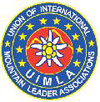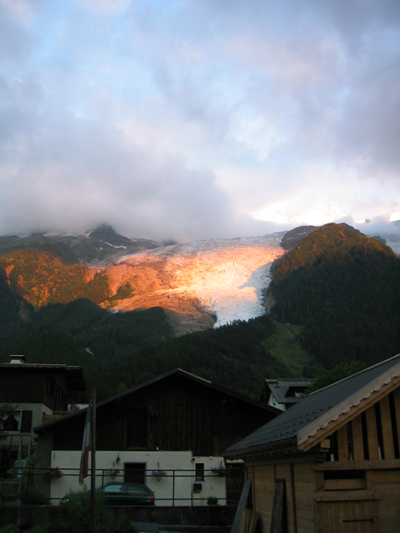

Above 2,900m south facing and 2,700m north facing the snow on the glaciers does not melt and the accumulation is superior to the ablation. Above 4,000m the snow only changes into ice very slowly and although some glaciers such as glacier des Bossons or Taconnaz have cold accumulation zones, the majority of alpine glaciers are formed lower down where the summer surface melt is sufficient to humidify the neve layer, raising its temperature to zero to form ice. At 3,530m on the col du Midi the neve is 5 to 6 metres thick, then 150m of ice before rock at 3,340m.

Although the speed of the glacier varies, it is around one metre a day. A tyre from the aircraft "Kanjenchunga" was recovered from the end of les Bossons glacier after travelling 7km in 37 years, around 200m a year.
A Chamionard in his 80s, an ex-pilot, told me that when he was young the glacier d'Argentiere came to the CMBH helicopter station near La Cremerie. Apparently it wasn't all fun back then though - kids were frequently sent on one-day pilgrimages to the numerous chapels dotted around the valley to keep them out of trouble!
I am available for trekking using refuges or one day hikes until 2 September for all levels and abilities. Many clients will enjoy having lunch at a mountain restaurant as part of a day out, such as le Chapeau or Chalet de la Floria, or even La Cremerie or Le Sarpe (les Bois) for an easy day. There will always be interesting things to point out concerning the history of the valley or the environment, and the flowers and butterflies are in full season at all altitudes.
A pine cone nibbled very close to the core, except for the tip, for the nuts on the scales at the centre will have been worked on by a rodent, some of which do not hibernate but dig tunnels under the snow.
But a squirrel has the strength to tear the scales when they are only part-nibbled, which leaves a tear on one side of the root of the scale. They hold the tougher tip on the ground and with one front paw hold the base in the air diagonally to work on the cone, either dropping the cones from a tree or leaving them strewn around a vantage point like a tree stump after they've finished. According to the tear marks you can see if a squirrel is right-handed or left-handed!
They don't hibernate completely but reduce activity, you can see them at the moment sometimes in the fine weather hopping around visiting old caches or topping up reserves.
Hibernation is a way of making it through the winter consuming a minimum of fat and reserves until food gets easier to find; the animal's heart beat and respiration slow dramatically although some species wake up to urinate and nibble at reserves.
Ladybirds hide under leaves,snails block their shells with saliva and frogs and certain fish cover themselves with grease hiding under the mud. Snakes sleep in tunnels a metre underground.
Not all small animals hibernate - squirrels stay in their nests during cold weather but come out to top up reserves in warm periods and the yellow necked mouse digs tunnels under the snow safe from predators.
Marmots of course hibernate en famille in a big chamber, with a toilet room nearby.
Chamois and ibex descend to the tree line, as do snow hares, but as with all the species they are right on the edge of survival in winter and many do not survive.
You can often find fox tracks (like a small dog's print with elongated claws) as they scurry around desperately searching for food. During my first winter in Chamonix I was alone high on the Dome du Gouter at 4000m being knocked flat by 100mph gusts and dodging large frozen pieces of broken-off sastrugi that were whipping past at high speed when I was astonished to see a little circle of orange fur dancing about in the spindrift near me on the edge of a crevasse - it was a pair of foxes fighting to to stay on the mountain as they were continually picked up and thrown by the wind. They had come up to scavenge where the wind had blasted clear the spot where they burn rubbish at the Aiguille du Gouter hut.
The snow hare's fur changes colour from pure white through patchy brown to brown. In some parts of Britain they never get past the patchy stage.
In the winter, in the Alps, snow hares tend to move down to the tree-line. They are smaller than a field hare, but have proportionally larger hind paws to support them on the snow, digging to feed on grasses, mosses and lichens. They survive in an incredibly hostile climate, making their forms in the windscoops behind rocks which you can sometimes find by observing their meandering tracks (from a telesiege is ideal. In very cold conditions, when disturbed, they hop away at almost walking pace just ahead of you, wasting no energy on unnecessary spurts, although in warmer weather they sprint away like a normal hare. Like much of the mountain wildlife they exist right on the limits of survival.
There is often a narrow tunnel dug into the side of the windscoop, which is not used except for shelter in case of attacks by eagles or foxes. Soon the males will start to behave strangely, perching on rocks to observe each other and trying to manoeuvre closer to the females before this develops into full-scale boxing matches. The females line their forms with their own fur to keep the young warm.
I found some interesting tracks in the valley between Mt Buet and the Brevent - large canide tracks apparently following an ibex track.
It is difficult to distinguish between wolf and large dog tracks - one difference being an extended claw mark at the front which appeared to be there. This valley is a little far for a dog to venture to alone, and there were no skier, snowshoe or foot tracks, although perhaps that's possible.
Animal tracks also massively expand in snow, especially in the sun, but I think fox tracks grown to this size would have a far less distinct pattern as the pad and toes merge. There have been no sheep attacked in the Chamonix area yet, although there have been problems above Chambery, less than 75 miles away across mountains.
Wolves have an advantage in certain snow conditions, as was clear from these canide tracks, their wide pads supporting their weight better than ibex, chamois or deer who sink deeply. Most attempts to find prey fail, especially if the wolf or wolves do not succeed in bringing the animal down in the first few minutes. There were numerous ibex and chamois down in this valley, perhaps forced there by human encroachment in their environment.
Wolves in particular need a safe area, often a clearing, to use as a meeting point and for raising the pack's cubs. It is normally only the alpha couple that mates and has young, but the whole pack participates in protecting and raising them. This is perhaps unavailable in the Chamonix area, and wolves prefer lower alpine terrain in general than we have here; it may just be dog tracks.
Simon Blackmore Accompagnateur en montagne 90 euros half day 130 euros a full day. Many mountain refuges are open at the moment for a days excursion with a traditional Savoyard lunch - either on snowshoes or, as the snow melts, on foot.
Simon Blackmore
Accompagnateur en montagne
SNOWSHOEING and TREKKING
all ages and abilities
age 6mths to 75yrs old.
I can also teach teenagers to build a proper mountaineers snow shelter!
Simon Blackmore 0687991472
My website's full URL is:-
http://uk.oocities.com/chamonixtrekking/index.htm
please feel free to put a link on your site, and I shall be glad to include a link to you in this web site, or get in touch.